The Astronomical Distance Scale

| Gene Smith's Astronomy Tutorial The Astronomical Distance Scale |

Radar + Newton's laws determine the AU (Astronomical Unit = 149,597,900km ~ 93,000,000 miles).
Parallax - Nearby Stars/500ly
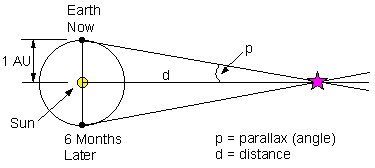
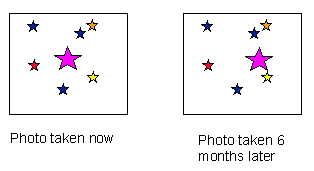
Cluster H-R Diagrams - Milky Way Clusters/100,000ly
Cepheid Variable Stars - Nearby Galaxies/50Mly
Variable stars have proven to be one of the most reliable types of
"standard candles". Cepheid Variables are giant stars which have
instabilities in their envelopes that cause them to pulsate in size,
temperature and luminosity over timescales of a few days. Below is the
light curve (brightness as a function of time) for
 Cephei, the variable star in the
constellation Cepheus
from which the stars derive their name. This
Mpeg animation shows the pulsation
of a cepheid.
Cephei, the variable star in the
constellation Cepheus
from which the stars derive their name. This
Mpeg animation shows the pulsation
of a cepheid.
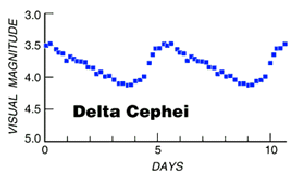
The pulsations of Cepheids are very regular;
 Cephei
has a period of pulsation (time between maxima or minima) of 5.366341
days. Furthermore the period is directly related to the
luminosity of the star as shown from the Period-Luminosity Relation.
Cephei
has a period of pulsation (time between maxima or minima) of 5.366341
days. Furthermore the period is directly related to the
luminosity of the star as shown from the Period-Luminosity Relation.
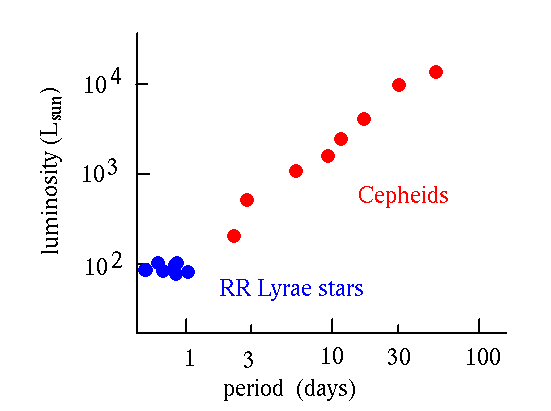
This relationship was first discovered by Henrietta Leavitt at Harvard who noticed that Cepheids in the Magellanic Clouds hae a relationship between apparent brightness and period in the sense that brighter Cepheids have longer pulsation periods. Since all the stars in the Magellanic clouds are about the same distance, this relationship must be a relationship between luminosity and period as well. Cepheids exemplify the desirable characteristics of standard candles:
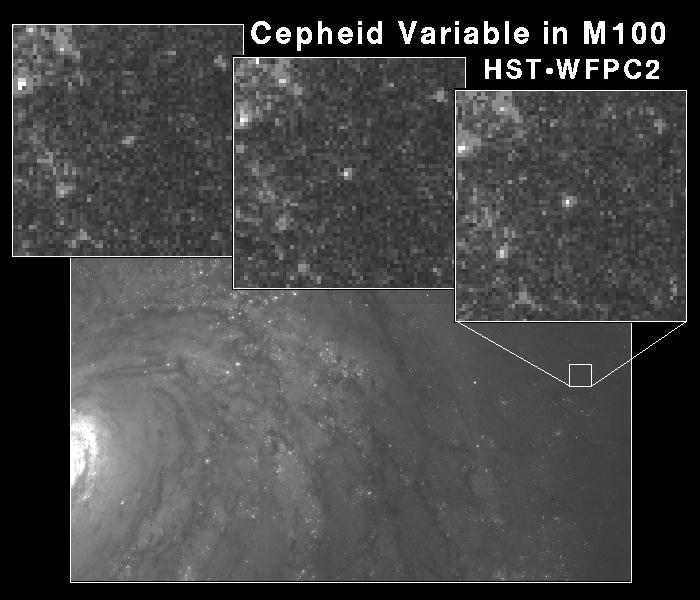
Supernovae
Probably the most promising new distance determination technique involves the
use of Type Ia Supernovae as "Standard Candles". Type Ia Supernovae
are white dwarf stars in binary systems in which mass is being transferred
from an evolving companion onto the white dwarf. If the amount of matter
transferred is enough to push the white dwarf over the
1.4 M
The doppler
shift is a shift in wavelength or frequency of a wave due to relative
motion of the source and receiver. If the source of waves is moving
toward the receiver (or vice versa) each successive wavecrest is
emitted a small distance closer to the receiver, the wavecrests will be
closer together and the wave will be"squashed as shown below (shorter
wavelengths & higher frequency). Similarly, if the source of waves is
moving away from the receiver each successive wavecrest is emitted a
small distance further away, the wavecrests will be further apart
and the wave will be"stretched" (longer wavelengths, lower frequency).
This is the phenomenon that causes the apparent shift in pitch (from higher
approaching to lower receding) as a train passes by sounding its whistle.
Because shorter wavelength is toward the blue and longer wavelengths are
toward the red for visible light, approaching velocities are said to produce
"blueshifts" and receding velocities produce redshifts. for speeds small
compared to the velocity of light the shift is given by:
From the work of Slipher in the early part of the 1900's astronomers knew that
most of the spiral nebulae (galaxies) are receding from us.
Edwin Hubble
demonstrated that there was a linear relationship between distance and
velocity for galaxies.
The data from Hubble's original velocity-distance relationship. Hubble's
distance scale was in error by a factor of several, but his result was a most
important one, demonstrating that the Universe is expanding and providing a
means of estimating the distances to galaxies at the "edge of the Universe.
Hubble's "law" is
with the modern value of the slope, H, called the
Hubble
Parameter (sometimes called Hubble Constant, but as we shall see it
is not constant):
The precise value of the Hubble Parameter is a matter of very hot
debate with different groups proposing values between 15 km/s/million l. y.
to 25 km/s/million l. y.
It is interesting to note that the units for the Hubble Parameter are 1/time
and the current estimate corresponds to a time of about 15 billion years.
What might this time correspont to?
Brightest Cluster Galaxies
 "Chandrasekhar limit"
for electron-degeneracy support, the white dwarf will begin to collapse
under gravity. Unlike massive stars with iron cores, the white dwarf will
have a C/O core which can undergo further nuclear reactions. The collapse of
the white dwarf liberates enough heat
that nuclear reactions ignite and blow the remnant apart in a thermonuclear
deflagration. These SNIa explosions have all the right characteristics for
Standard Candles; they are:
"Chandrasekhar limit"
for electron-degeneracy support, the white dwarf will begin to collapse
under gravity. Unlike massive stars with iron cores, the white dwarf will
have a C/O core which can undergo further nuclear reactions. The collapse of
the white dwarf liberates enough heat
that nuclear reactions ignite and blow the remnant apart in a thermonuclear
deflagration. These SNIa explosions have all the right characteristics for
Standard Candles; they are:
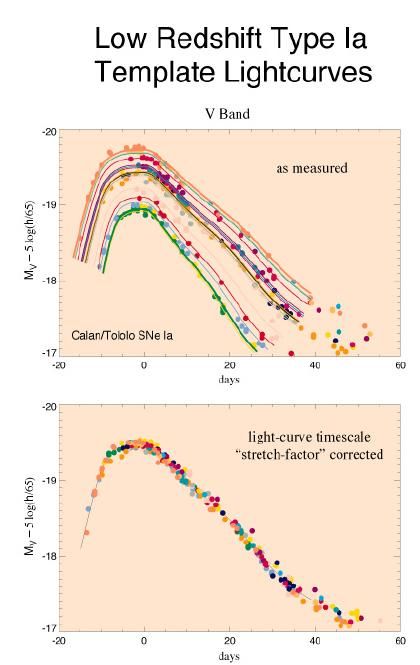

Diagram from Ned Wright's
ABC's of Distances
© Edward L. Wright (UCLA); used by permission.

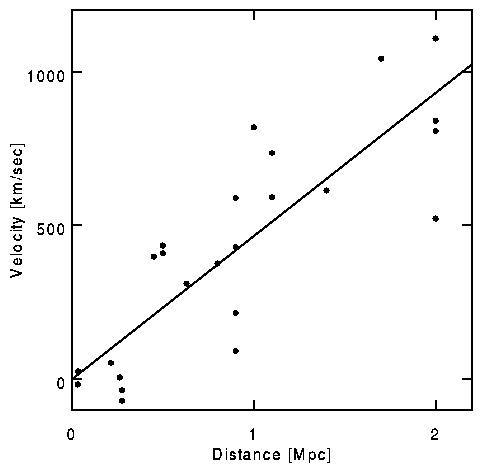
Hubble's (1929) Velocity-Distance Relation for Nearby
Galaxies
Diagram from Ned Wright's
ABC's of Distances
© Edward L. Wright (UCLA); used by permission.
 20 km/s/million l. y.
20 km/s/million l. y.

![]() Galaxies
Galaxies
![]() The Interstellar Medium
The Interstellar Medium
![]() Education & Outreach
Education & Outreach
![]() CASS Home
CASS Home
Comments?
Gene
Smith
Conducted by:
Prof. H. E. (Gene) Smith
CASS 0424 UCSD
9500 Gilman Drive
La Jolla, CA 92093-0424
Last updated: 22 April 1999